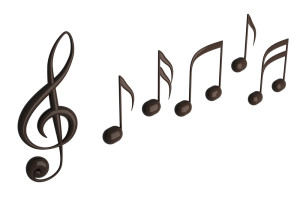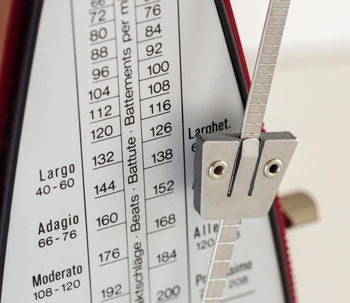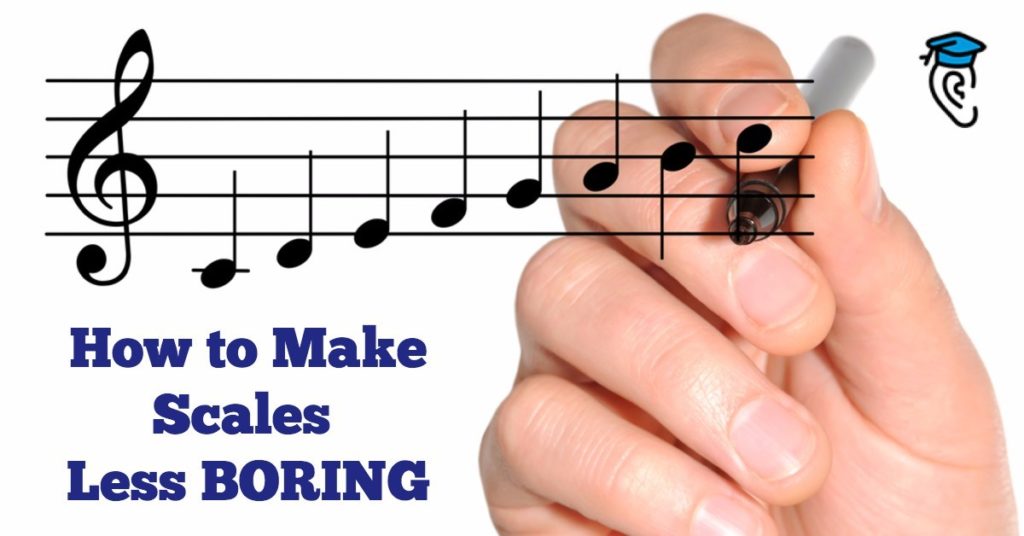Scales can be the bane of a musician’s life. Particularly in the early stages when you’re just getting started with an instrument and working through grade exams, you have to learn a lot of scales – and between learning the key signatures and teaching your fingers to do what they should, it can take many hours of long and boring practice.
Recently inside the Musical U community we had this question come up:
How can I make practicing scales more interesting?
At Musical U we teach an approach called the MAGIC framework for goal setting which helps to ensure you set truly motivating and effective goals in your musical life. Two important aspects of that are making your goals musical and making them interesting. The member who was asking the question above was (understandably) finding it hard to do that when it came to learning his scales!
We came up with a few suggestions to help him get excited about learning his scales and I’ll share these below.
Before we get into that though: what is it that makes scales so bad in the first place?
The problem with scales
Scales are, by nature, pretty dull. Like music theory, they are a good example of the major problem with traditional music education: if it’s taught in a way which makes it boring, the whole process of learning music can become tedious and frustrating.
 It’s all too easy to get bogged down learning things you “should” learn, and forget what got you excited about music in the first place.
It’s all too easy to get bogged down learning things you “should” learn, and forget what got you excited about music in the first place.
However, just like music theory, if you approach scales in the right way, you can avoid the boredom and bring that exciting “spark of music” to them – and even come to enjoy and appreciate their role in your musical life.
In fact, scales turn out to be so dull that the problem brings its own solution – but more on that below.
What is it that makes scales dull to begin with?
What is a scale – and what is it missing?
We think of a scale as being a particular set of notes, played in a particular order. Normally we play them ascending in pitch, and then descending in pitch.
We learn them to get to know a key (i.e. the sharps and flats) and get our fingers fluent on the instrument to play in that key. There are normally particular fingering patterns, such as on keyboard or guitar, or there is fluency with the instrument’s keys, such as saxophone or trumpet. Or in the case of singing, they are useful to gently explore your vocal range and develop pitch accuracy for singing sequences of notes.
As discussed in How Musicians Should Spend Their 10,000 Hours, there are three aspects to learning music – or rather, there should be!
For many of us, we get narrowly focused on just one: the instrument skills. However, learning music theory and developing your musical instinct with ear training are just as important.
With scales you’re learning a bit of theory (the key signature) and then mostly focusing on instrument skills (getting those fingers fast and reliable playing through the scale at increasing speeds). But what about your ear?
Therein lies the problem and its solution: bring some listening skills to your scales, and practising them quickly becomes a whole lot more interesting…
How to make scales interesting
There are two ways to answer the question of “how can I make scales interesting?”
The first is a “big picture” answer and the second is more practical.
1: Start with Why
As Simon Sinek explains in this excellent TED talk it’s important in a project to always start from your “why” – that’s what can keep you motivated through adversity and help ensure you keep moving towards a goal which inspires you.
Inside Musical U we teach our members to begin from their “big picture vision”. Before ever setting a training goal, we help them to get really clear on who they actually want to become as a musician, and what exactly life will look like when they get there.
Once you know that, figuring out the specific training goals and plans becomes much easier.
The same holds true for scales: one simple answer to the question of making scales “interesting” is to connect them with what interests you.
Why are you learning scales to begin with?
- Maybe you’re learning scales because you want to join a band and you know scales will give you the instrument skill to do it
- Maybe you’re learning scales to pass an exam so that you can be a music major in college
- Maybe you’re learning scales to help you improvise freely and easily
Whatever the case, until you figure out your true reason for learning scales, they’ll always seem like tedious drudgework. If your current reason is “because I should” or “because my teacher told me to”, dig a little deeper!
Then, start every practice session by taking a moment to remember your “why”, and you’ll feel a burst of motivation to get those scales mastered.
2: Make them Musical
The answer above is reasonable – but it’s also a bit of a cop out! Starting with “why” will make your scale practice easier to get motivated about, but it doesn’t really address the problem of scales not being musical or interesting… So what can you do about that?
 If you make scales more musical, they will be more interesting to practice. The way to make them musical is to bring back that third area of musicianship I mentioned above, which you’re probably currently neglecting completely in scale practice: your ears!
If you make scales more musical, they will be more interesting to practice. The way to make them musical is to bring back that third area of musicianship I mentioned above, which you’re probably currently neglecting completely in scale practice: your ears!
The best instrument teachers do pay some attention to this. They’ll remind you to listen carefully as you play the scale, and bring some phrasing or expression to it. To focus on your tone if you’re a wind player or singer. Unfortunately that only goes so far, and most students default to seeing scales as a “right or wrong” exercise of simply trying to play the right notes at the right speed, like a robot.
To make your scales musical you need to… make them into music! And that’s what I meant when I said it’s a problem which brings its own solution. Because scales are so boring, they are actually the perfect opportunity to practice your musicianship and bring out your musical instinct.
Like adding constraints can make improvisation easier, when you’re forced to work with just the notes of a scale it makes you be more creative in terms of musical expression.
We’ll look at a few specific examples below, but the basic point is this: always start your scales practice by asking “What can I do to make these scales sound more like music?”
A. Playing Patterns
The first simple strategy for making scales more musical is to adjust your playing pattern.
We traditionally play scales with the notes ascending, tonic up to tonic again, perhaps through more than one octave – and/or descending back down. This is typically the requirement in exam grades, and it’s the basic music theory definition of a scale.
However, another way to think of a scale is simply as being the notes of a key – in which case you’re a bit more free to play around with their order.
Try playing the scale in three-note runs:
(this is a particular favourite in guitar solos!)
Or little note pairs:
Or arpeggios and other variations:
Find different ways to play combinations of notes from the scale, and practice with the same pattern across each key whose scale you’re working on.
Although this may not help you get lightning fast at the up-and-down version of the scale, it does help you gain true fluency moving around in the scale. This is actually far more useful for improvisation and for playing new pieces in that key, since you’ll be using little sections and runs of the scale like this rather than the full up-and-down pattern anyway.
B. Rhythmic Variations
Another strategy you can use to make scales more musical and interesting is it introduce variations on the rhythm.
Again, the exam-style approach to scales has you play them quite robotically, making each note the same duration. There certainly is value in that, to help you internalise a steady beat and learn to play note durations accurately and consistently.
However, once you’re past your first few exam grades you probably have that consistency mastered, and you can feel free to make your scales practice more interesting by mixing up the rhythms you use.
For example, try swinging it:
or playing triplets:
or just simply making up simple rhythms each time:
Again, pick a rhythm and use it for each scale you practice in a session. Then next time you return to practice it again, maybe introduce a new idea. This way you gradually build a more versatile approach to scales and keep it interesting for yourself.
Notice here how sometimes the end of the scale needs to change a bit to fit a neat four-bar phrase – this is a good example of where you’re starting to train your musical instinct by answering the question “how can I make this sound like music?”
C. Tone Variations
Every instrument has a variety of tones you can produce. With some, like the human singing voice, there can be huge variety: think about volume, the syllable you sing on, vowel shaping, how broad or narrow your voice is, breath support, and more. With guitar you have the fingering technique, along with all kinds of audio effects. With wind instruments your embouchure can produce a range of sounds. And even a keyboard instrument like piano can allow for a variety of tones.
Bring this variety to your scales practice and use them as a playground for developing your mastery of the full range of tones your instrument can produce.
An easy way to break into this strategy is to ask yourself “how different can I make this scale sound from the last time I played it?” without altering the playing pattern or rhythm of the notes you play.
You might be surprised at the variety of ways you can play a scale just by experimenting with tone!
D. Backing Tracks
 As mentioned above, scales are useful to develop your rhythmic consistency and to gain fingering fluency at increasing tempos. For these reasons, they’re often practised using a metronome beat, at least to begin with.
As mentioned above, scales are useful to develop your rhythmic consistency and to gain fingering fluency at increasing tempos. For these reasons, they’re often practised using a metronome beat, at least to begin with.
But a metronome is not all that musical, is it?
Of course, it is musical in the sense that scales are musical: they are the fundamental skeleton of music, the steady beat and the notes of the key. But when stripped down to that purest form they become a bit boring, right?
So another strategy for making your scales practice more interesting and musical is to substitute out your metronome for another time source.
A simple option is to use drum loops. Instead of a 60 BPM steady tick of a metronome:
try a 4/4 rock beat:
or something with a bit of latin flair
You can even take this a step further by finding a backing track in the key you’re playing in, and use that as your accompaniment for scales practice.
This is another great opportunity to connect scales with what is truly interesting to you in the bigger picture of music. For example, why not practice scales along with songs by your favourite band? It also leads naturally into improvisation and play-by-ear practice – you almost can’t help but start trying to play the song’s melody using the notes of the scale, or experimenting with rhythms and patterns to match the style of the song!
Unboring-ify Your Scales
Which of the strategies above is a good match for you will depend on why you’re learning scales to begin with.
If you’re learning scales to gain fingering fluency or help you improvise, then the playing patterns and rhythmic variations will be great. These help you to explore the scale in different ways while training your brain and fingers to stay within the notes of the scale.
On the other hand if your only goal is to pass an exam (which would be a shame…) then you’ll want to focus much more on playing scales in the traditional way, up and down – but you can still take advantage of strategies like the backing tracks approach mentioned above to keep it a bit more interesting.
The strategies suggested are all just starting points for you. Each can be explored much further, and no doubt you will find other ways to bring your own musicality to your scales. These are just intended to help you see how “practising scales” does not have to mean “playing the same thing every time, robotically”.
There is a time and a place for that rigid training of your fingers to meet exam requirements, but for the most part you should aim make your scales practice much more interesting – and much more musical!







